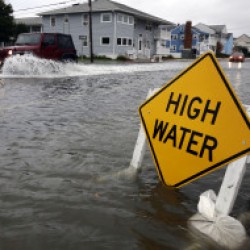In today’s Wall Street Journal “Sightings” column I look at how artists respond to great public events like Hurricane Sandy–and how amateurs sometimes do a better job. Here’s an excerpt.
* * *
Here’s a safe bet: The e-mailboxes of every editor at every publishing house in Manhattan are filling up with proposals for novels about Hurricane Sandy. And here’s a safer one: If any of them actually get written, they’ll be awful.
 Artists of all kinds have a weakness for Big Statements. But few of them are equal to a challenge the size of Sandy, which laid waste to much of the eastern seaboard. Consider the art created in response to 9/11. Was any of it good? Truth to tell, just about all of it is already forgotten, and rightly so. Novelist Jonathan Safran Foer’s “Extremely Loud and Incredibly Close,” classical composer John Adams’ “On the Transmigration of Souls,” singer-songwriter Neil Young’s “Let’s Roll,” sculptor Eric Fischl’s “Tumbling Woman”: All now seem hopelessly inadequate to the task of embodying such an event, much less clarifying its human impact….
Artists of all kinds have a weakness for Big Statements. But few of them are equal to a challenge the size of Sandy, which laid waste to much of the eastern seaboard. Consider the art created in response to 9/11. Was any of it good? Truth to tell, just about all of it is already forgotten, and rightly so. Novelist Jonathan Safran Foer’s “Extremely Loud and Incredibly Close,” classical composer John Adams’ “On the Transmigration of Souls,” singer-songwriter Neil Young’s “Let’s Roll,” sculptor Eric Fischl’s “Tumbling Woman”: All now seem hopelessly inadequate to the task of embodying such an event, much less clarifying its human impact….
Who, then, will best tell posterity what it was like to be on the receiving end of Sandy? If I had to guess, I’d look to the innumerable photographers–most of them point-and-shoot amateurs–who have spent the last couple of weeks sharing images of the storm and its aftermath on Flickr and Instagram. Their snapshots are anything but slick. All they show is how things looked: Refrigerators in front yards, uprooted trees and caved-in roofs, flooded tunnels, darkened houses on the edge of collapse, and water everywhere. Naïve? Sure, but that’s what makes them so telling. Another way of describing them is unpretentious. Such photos are properly modest in the face of the nightmare that is a natural disaster. Instead of preaching a sermon, they invite you to look–and despair….
* * *
Read the whole thing here.
Terry Teachout on the arts in New York City
An ArtsJournal Blog
